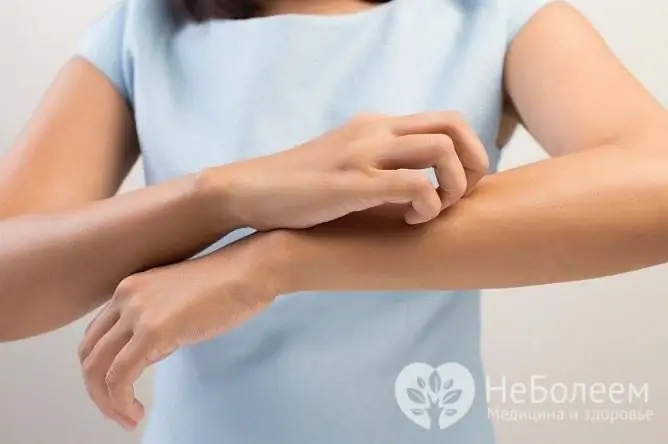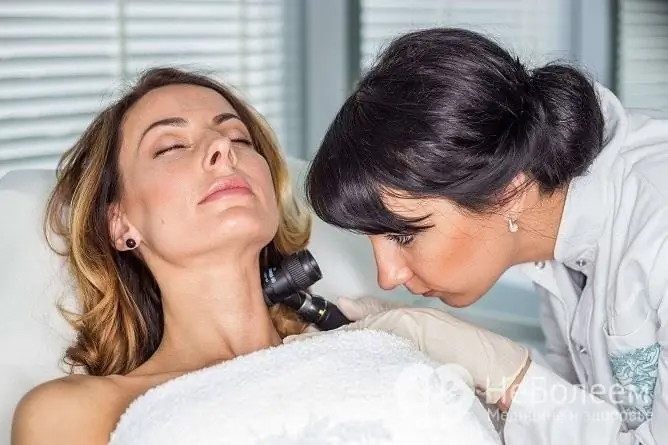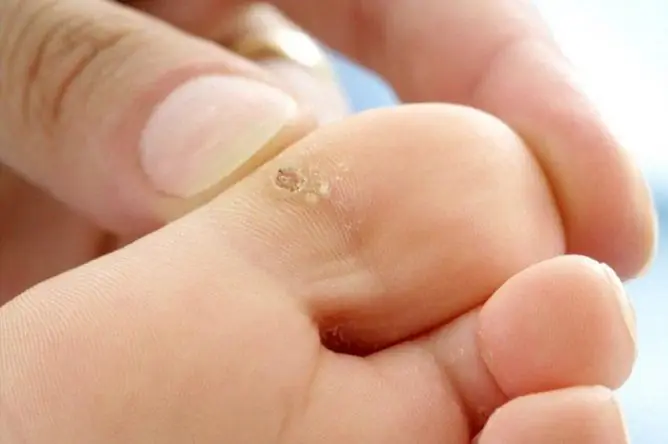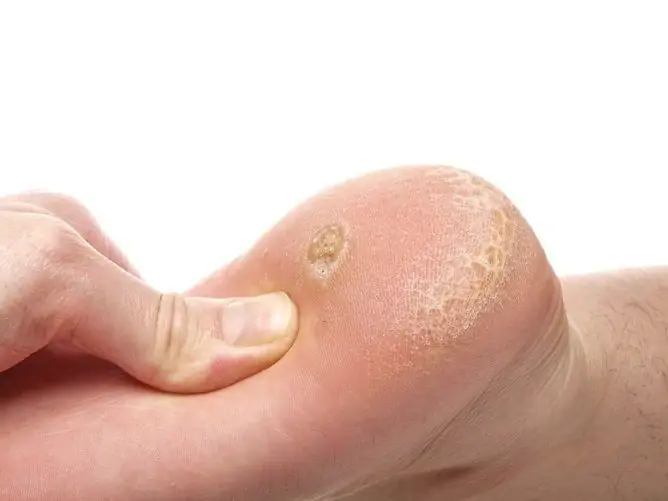- Author Rachel Wainwright [email protected].
- Public 2024-01-15 19:51.
- Last modified 2025-11-02 20:14.
Why does a mole itch and what to do about it
The content of the article:
- Symptoms of activation of nevi
- Causes of itching
- Therapeutic tactics
- Video
A mole, also called a birthmark or nevus, is a benign skin growth resulting from the accumulation of melanocytes - cells containing the pigment melanin. Under the influence of provoking factors, some nevi can degenerate into melanoma, which is considered one of the most aggressive, rapidly metastatic human malignant tumors. If a mole itches, then this may be one of the early symptoms of malignant transformation. Consultation with a dermatologist and additional examination will allow you not to miss a dangerous disease.

If a mole itches, this is a reason to consult a doctor to exclude the possibility of its rebirth.
Symptoms of activation of nevi
Almost every healthy person has one or more moles. They can exist from birth or arise during the first decades of life due to genetic predisposition or under the influence of external factors. Most skin pigment lesions are benign, but the possibility of transformation into cancer should not be discounted.
When to see a doctor? Signs that indicate an increase in proliferative activity or even malignancy of a nevus are:
- rapid increase in size;
- modification, the appearance of asymmetry;
- compaction of one of the areas, the appearance of more convex structures;
- change in color or intensity of color;
- itching or burning;
- ulceration, bleeding;
- cessation of hair growth on the surface;
- the emergence of additional formations along the periphery.
The appearance of at least one symptom is a sufficient reason to see a doctor. This does not mean that the degeneration of the pigment formation begins or there is a question of immediate removal of the nevus, but it is necessary to be on the safe side.
Only if a serious diagnosis is ruled out, you can safely deal with the problem of itching in the area of the mole.
Causes of itching
When a mole itches, the reasons can be varied.
| Provoking factor | Action taken |
| Ultraviolet spectrum radiation | One of the main functions of the melanin pigment, which is synthesized by melanocytes and accumulates in them, is the absorption of ultraviolet (UV) rays. Thanks to this mechanism, the deep layers of the skin are protected from radiation damage. With excessive exposure to ultraviolet radiation, melanin is produced more intensively, which, in turn, provokes the formation and growth of age spots. The source of natural UV radiation for humans is the sun, artificial - ultraviolet lamps used for various purposes, including to obtain artificial tanning. Prolonged sunbathing and frequent visits to the solarium can result in a mole starting to itch and grow. |
| Mechanical trauma | The existence of moles in certain places on the body of a child or an adult can contribute to their trauma: with a comb when localized on the scalp; belt, belt of trousers or skirts when located on the stomach and back; bra for localization on the chest. Often, nevi on the face of men are damaged when shaving with a razor or straight razor. In addition to the fact that the integrity of the mole is violated during injury, it can hurt and itch, and the skin around the formation can turn red and peel off. |
| Chemical substances | Numerous chemicals found in powders, detergents, rinses, cosmetics, deodorants can be irritating and toxic to the skin and the birthmarks on it. In addition, very often the skin around the pigmented formations is very itchy, becomes red when wearing clothes made of synthetic fabrics. |
| Skin diseases |
Inflammatory and autoimmune skin diseases, accompanied by its swelling, redness, dryness and flaking, can be factors that provoke the appearance of itching in the nevus area. If you scratch the affected area, then mechanical damage will only increase the discomfort and will contribute to the infection of the pigment formation. Especially you should not scratch a mole if it is difficult to control it visually: for example, when a mole on the back itches. |
| Allergic reactions | Certain foods, medicines, skin care products, cosmetics, perfumes can be an allergen for a particular patient and cause itching in the nevus area. These unpleasant sensations are usually accompanied by hyperemia and swelling of the affected area. |
| Hormonal adjustment | Hormonal changes at certain periods of life (puberty, pregnancy, menopause) and various endocrine diseases sometimes lead to an increase in the number of birthmarks, an itching sensation, a feeling of tension, and existing nevi noticeably grow. |
Therapeutic tactics
What should a patient do to get rid of itching? The very first thing to do is see a doctor. Why is it impossible to engage in treatment without consulting a dermatologist? Because even the minimal possibility of malignancy should be excluded. If you deal with the problem of itching without a specialist examination and dermatoscopy (assessment with an optical dermatoscope), you can waste time and miss the tumor at an early stage, when it can be removed radically, thereby preserving health.

Dermatoscopy allows you to identify suspicious moles and determine if they need to be removed
All moles are divided into two large groups: dangerous in relation to the development of melanoma and non-dangerous.
| Type of pigment formation | Therapeutic tactics |
| Melanoma |
The presence of an itchy mole, which is dangerous for the development of melanoma, requires active tactics. First of all, it is unacceptable to carry out various cosmetic or irritating effects, including excessive sun exposure, taking medications, inadequate surgical interventions: partial excision, cauterization, freezing, laser evaporation. Adequate surgical removal of a melanoma-prone nevus involves the excision of at least 10 mm of unchanged skin around it. The depth of the excision is also of great importance. It is necessary to remove it with the underlying layer of subcutaneous fat (within 3-5 mm), since nevus cells can be located in the deep layers of the dermis. Subsequent histological examination of the material is mandatory. |
| Melanomone-dangerous | If the benign nature of the mole is confirmed, then itching can be effectively eliminated only taking into account the cause of its appearance. When the etiological factor is UV radiation, sensitivity can be reduced by covering the mole from the sun with a gauze bandage, using special protective creams. Elimination of the negative effects of chemicals, allergens, treatment of inflammatory diseases, normalization of hormonal levels are the main ways to solve the problem of itching. It is always necessary to moisturize the skin, as excessive dryness and peeling contribute to irritation and trauma of the skin and pigmented formations. |
With regard to age spots, especially those accompanied by itching, there should always be oncological alertness. Trying to get rid of such moles with folk remedies (vinegar, garlic, lemon, infusion and celandine juice) is categorically contraindicated, as this can become an impetus for tumor growth.
Video
We offer for viewing a video on the topic of the article.

Anna Kozlova Medical journalist About the author
Education: Rostov State Medical University, specialty "General Medicine".
Found a mistake in the text? Select it and press Ctrl + Enter.






